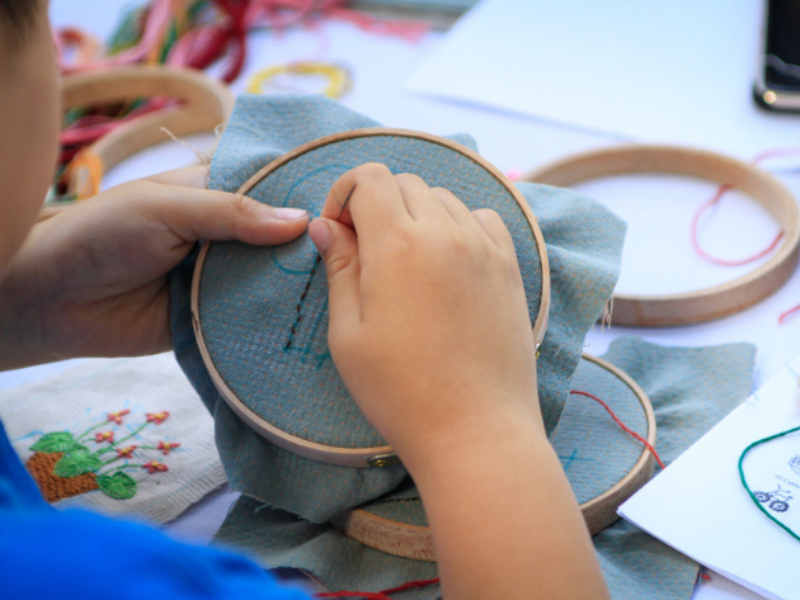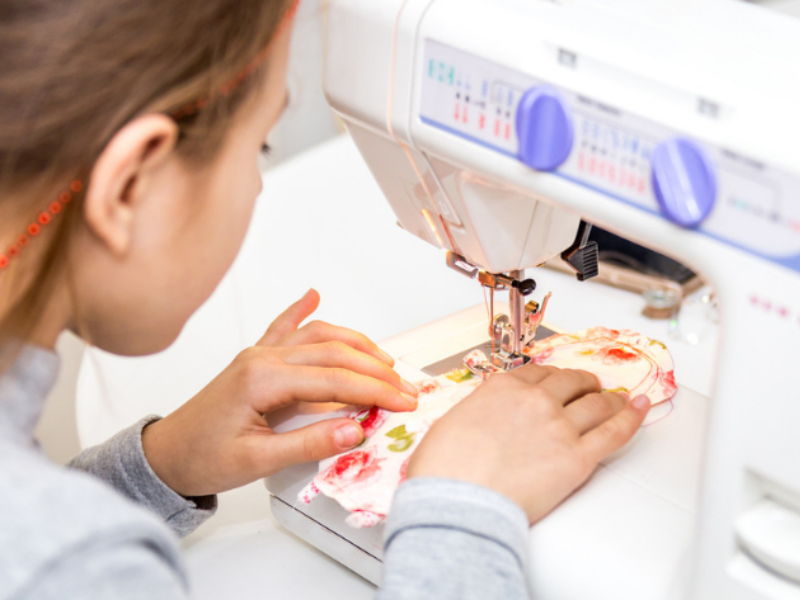Evangeline Do of Handmade Beginnings shares 5 great tips to help teach sewing to your kids, no matter their age.
Updated November 2024
My name is Evangeline, and I am a mother of four. In my family, sewing skipped a generation so I didn’t learn to sew as a child, but instead I learned to sew in my high school fashion class.
I’ve sewed ever since: creating clothing for myself, my kids, as well as handmade toys for my online shop.
For many years, I have taught children how to sew, whether it be to my family members, my children, or students who come to my home studio for sewing lessons. I’ve learned a lot about working with children and the best ways and ages to teach children how to sew.
If you’re looking to introduce your kids to sewing, here are my five tips!
5 Tips to Teach Sewing for Kids

1. Assess Their Skill Level
The age of the child can play an important part in what we teach them about sewing as it directly correlates to their fine motor mastery. Here is a general timeline of what and when to introduce sewing to kids based on my experience:
- Ages 2-4: Lacing cards, threading large beads
- Ages 5-7: Basic Stitches, embroidery, cross stitch, sewing with felt
- Ages 8-10: Introduction to the sewing machine, and small beginner projects and patterns
- Ages 11 and up: An introduction to garment construction and techniques
That being said, every parent and educator knows that each child is unique and will master skills and concepts in their own time. Some children will be ready for garment construction at age 8, and some will be ready at age 12. Neither is right nor wrong, and it’s always a good idea to follow the lead of the child.
You can introduce new concepts by age but also be aware of their individual level and cater to that as no two children are alike.

2. Break it Down
Learning to sew is also learning the art of patience. Sewing can often be frustrating and very time consuming. Helping kids break down projects into bite-sized steps can help boost their confidence and ensure they don’t get overwhelmed.
I like to choose projects for my beginner students that I know they can complete within the 1-2 hour time frame of our class. This allows them take their project home and feel a sense of accomplishment. It also encourages an eagerness to return and create something new next week.
Related Stories from The Artful Parent
Experienced sewers can sew more complex projects that span the course of a few weeks, but even then it is a good idea to break it into clear goals and benchmarks.

3. Practice Makes Progress
Sewing mastery takes hours of practice. After sewing several hundred handmade toys, I can still say I have more to learn about sewing.
The more children practice sewing techniques the better they will become at them.
If your child is struggling with a certain technique, like sewing on a button, try to give them multiple projects that incorporate buttons until they are confident with the skill. Or document the child’s progress by photographing their projects and returning to them a few months, or even a year later to see how far they’ve come.

4. Mistakes Happen
There’s a famous saying in the sewing world “Measure Twice, Cut Once” and it is for good reason. Mistakes are bound to happen. It is the very reason the seam ripper was invented.
Teaching children how to undo their mistakes is just as important as teaching them how to sew. Even the most skilled seamstress makes mistakes and that’s okay.
- People who don’t feel lonely in their later years often adopt these 9 habits that most people ignore until they’re struggling - Global English Editing
- The art of appearing effortlessly classy: 9 habits wealthy people practice without thinking - Global English Editing
- 10 things people over 65 stop caring about that younger people are still obsessing over - Global English Editing
If your child is facing a sewing problem, it is a great opportunity to work through problem-solving and decide on the best course of action. Sometimes mistakes can’t be undone and there will be times when we need to start over, but that is all a part of the learning process.

5. Be Unique
I’m really passionate about not just teaching kids to follow a pattern step-by-step. I want to teach kids mastery of sewing skills so they can confidently design and sew their own masterpieces.
If you give a child a paintbrush and paint, more often than not, you’d let the experience be open-ended. The child is allowed to paint whatever their heart desires. It’s important to be open in the same way with sewing.
Once your child learns the basics of sewing, give some fabric and thread and room to create. Everyone’s uniqueness and brilliant ideas shine best when they are given the time and space to explore and play with materials.
I hope you enjoyed my 5 best tips for introducing sewing to children. I love when I see more children learning how to sew. It is a bit of a lost art but is also definitely making a comeback!
Do you have a child that is interested in learning how to sew? I’d love for you to follow along with me on Instagram where I share lots of sewing tips and projects made by children in my new online Sewing Camp program.
More Fabric Arts and Crafts for Kids
- How to Make a Wooly Wall Hanging
- 10 Yarn Art Activities for Kids
- Fashion Design for Kids Made Easy with Activity Kits
- How to Paint Lace with Kids
- How to do Simple Stitching with Kids
- How to Make Sharpie Tie Dye Pillows
Pin It for Later






